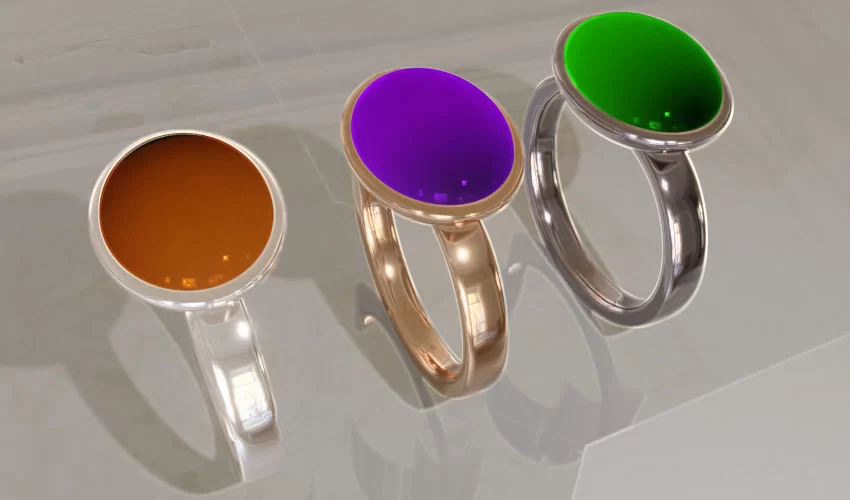
Have you ever seen someone wearing a ring that changes color based on their mood? It’s called a mood ring, and it’s been a popular piece of jewelry since the 1970s. But have you ever wondered how mood rings work? In this article, we will delve into the science behind mood rings and explain how they are able to change color based on your emotions.
Mood rings contain a special liquid crystal that responds to changes in temperature by twisting and altering the color of the crystal. The color that the crystal turns is believed to be associated with a particular emotion or mood. For example, blue or green may indicate that you are feeling calm, while yellow or orange may indicate that you are feeling anxious or excited.
But how accurate are mood rings? Can they really tell you how you are feeling? While there is no scientific evidence to suggest that mood rings are accurate, they can be a fun and unique way to express yourself and show off your mood to others.
So, if you’re interested in learning more about the science behind mood rings and want to find out what your ring might be telling you about your mood, keep reading!
History of Mood Rings
The concept of mood rings dates back to the ancient Greeks, who believed that different colors had the power to evoke different emotions. However, it wasn’t until the 1970s that the first mood rings were created.
The first mood ring was invented by two New York inventors, Josh Reynolds and Maris Ambats, in 1975. The ring contained a hollow glass shell filled with a special liquid crystal that changed color based on the temperature of the wearer’s skin.
The liquid crystal was made up of several different chemicals, including leuco dyes and thermochromic crystals. When the temperature of the skin changes, the chemicals would react and cause the crystal to change color.
The Popularity of Mood Rings
Mood rings quickly became popular in the 1970s, thanks in part to their association with the hippie movement and the New Age spirituality that was popular at the time. They were seen as a fun and unique way to express oneself and connect with others.
As their popularity grew, manufacturers began producing mood rings in a variety of styles and designs, from simple silver bands to elaborate, gemstone-studded rings. They even created mood necklaces, earrings, and bracelets.
The Decline and Resurgence of Mood Rings
By the 1980s, the popularity of mood rings had declined, and they became associated with cheesy gimmicks and novelty items. However, in recent years, mood rings have experienced a resurgence in popularity.
Today, mood rings are often worn as a nostalgic throwback to the 1970s or as a trendy fashion accessory. Some people still believe in the idea that mood rings can reveal their emotional state, while others simply enjoy the unique and eye-catching design.
The Science Behind Mood Rings
Mood rings are made from a special type of liquid crystal that is sensitive to changes in temperature. These crystals are made up of long, thin molecules that are arranged in a regular pattern. When they are exposed to heat, they move and twist, changing the way they reflect light. This change in light reflection causes the color of the mood ring to change.
How Mood Rings Measure Temperature
The liquid crystal in mood rings is placed inside a small, sealed chamber that is attached to the metal band of the ring. When the temperature of the wearer’s skin changes, the liquid crystal inside the chamber also changes temperature. This causes the dyes in the crystal to change color, which is then reflected in the color of the mood ring.
It’s important to note that the temperature of the wearer’s skin is not necessarily an accurate representation of their emotional state. Rather, it is an indication of changes in blood flow and other physiological processes that are associated with emotions. While mood rings are not scientifically accurate, they can still be a fun and interesting way to monitor changes in your body temperature throughout the day.
Interpreting Mood Ring Colors
Different colors of mood rings are thought to represent different emotions. For example, blue is said to represent calmness, while red represents excitement. However, there is no scientific evidence to support these claims. People may interpret the colors of their mood rings based on their personal experiences and beliefs.
We published a detailed guide on mood ring colors and their meanings. Read it to get more perspective on the various colors of your mood ring.
Accuracy of Mood Rings
While mood rings can be a fun and interesting accessory, they are not a reliable indicator of a person’s emotions. There is no scientific evidence to support the idea that they can accurately reflect a person’s emotional state. Mood rings may change color based on a variety of factors, including temperature, body chemistry, and even the color of clothing worn by the wearer.
Other Uses of Liquid Crystals
Liquid crystals have many practical applications beyond mood rings. They are commonly used in displays and screens, such as those found in calculators and watches. They are also used in electronic devices like televisions and computer monitors. Ongoing research is exploring the potential use of liquid crystals in new industries, such as medicine and energy storage.
How to Care for Mood Rings
To keep a mood ring in good condition, it is important to avoid exposing it to extreme temperatures or chemicals. Mood rings should be stored in a cool, dry place when not being worn. They should also be kept away from water, as moisture can damage the liquid crystal material. If a mood ring becomes damaged, it may not change color properly or at all.
Conclusion
In conclusion, mood rings are a fun and intriguing accessory that has been popular for decades. While they are not an accurate reflection of a person’s emotions, understanding the science behind them can add to their appeal. Liquid crystals are sensitive to temperature changes, which causes the color of the mood ring to change. Mood rings can be cared for by avoiding extreme temperatures and storing them in a cool, dry place. They can be purchased at many retailers and online stores in a variety of styles and colors.
Overall, mood rings are a unique and interesting accessory that can add a touch of fun to any outfit. While they may not provide an accurate reflection of a person’s emotions, they are still fascinating examples of the science behind materials and their reactions to environmental factors.
FAQs
Can mood rings actually tell your mood?
No, there is no scientific evidence to support the idea that mood rings can accurately reflect a person’s emotions. They simply change color based on temperature changes.
Are mood rings safe to wear?
Yes, mood rings are generally safe to wear. However, they should be kept away from extreme temperatures and chemicals that could damage the liquid crystal material.
Do all mood rings have the same color meanings?
No, different manufacturers may have different color interpretations for their mood rings. It is important to read the instructions that come with the ring to understand its specific color meanings.
Can you shower with a mood ring on?
It is not recommended to shower with a mood ring on, as exposure to water can damage the liquid crystal material.
Can mood rings be resized?
Some mood rings can be resized, depending on the design. It is best to check with the manufacturer or retailer for instructions on how to resize a specific mood ring.

